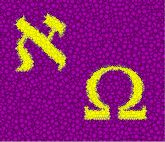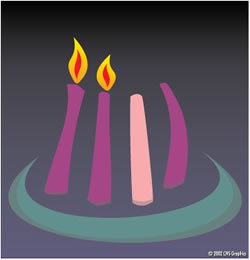|


Advent is a season that begins on the fourth Sunday before Christmas, when the Church commemorates the centuries of waiting for the arrival of the Savior promised to the Jews in the Old Testament. For Christians, the season of Advent is a time of quiet meditation in preparation for the Christmas celebration in honor of the birth of Jesus.
Each of the four weeks before Christmas in churches, and in many homes, candles will be lit on an Advent wreath. The history of using a lighted wreath of greens to celebrate the anticipation of the birth of Christ dates to the 9th century AD, when Catholics adopted the candle-lit wreath as a symbol of faith.
The circle is an ancient symbol, used by many ancient cultures to symbolize eternity. The evergreen branches are also ancient symbols for eternal life. Christians took these ancient symbols and "baptized" them, giving them Catholic meanings. The candles symbolize the Christ Child, the Light of the World. Together, the Advent wreath then, is a message, that symbolizes Jesus Christ, the Eternal Light of the World.
By the 16th century Catholics throughout Europe commonly used these symbols to celebrate their faith in thee Trinity. Homes, churches, and public buildings all across Europe used Advent wreathes.
Traditionally, the Advent wreath is made of four candles in a circle of evergreens. Three of the candles are purple, and one is pink ( rose ). Each day the candles are lighted, perhaps before the evening meal- one candle the first week - lighting an additional candle each succeeding week, until Christmas Eve.
Purple, symbolizes penitence ( sorrow for wrong-doing ) and humility. Advent is a time of solemn preparation for the Feast of Christmas - the dawn of new Light in the world and the fulfillment of Hope, with the birth of Jesus. Although most people tend to equate the Christmas season with joy and anticipation, during our Advent reflections we pray and meditate on the reasons why God had to send us a Savior. Thus, Advent is actually seen as a "penitential" season.
Rose, symbolizes joy. The rose colored (pink) candle is burned beginning with the third week of Advent to symbolize the "half-way" point in the dark time of waiting. The third Sunday of Advent is called "Gaudete Sunday". Gaudete is the Latin word for "joy," and on Gaudete Sunday we focus on our anticipatory joy in the coming of our Savior, Jesus the Christ.
How to Use Your Advent Wreath
The idea is to use the wreath in conjunction with worship services or personal or family devotions on the four Sundays in Advent. You light candles at the beginning of each service and extinguish them out at the end of the service.
- On the first Sunday in Advent, you light the first candle. Have your service, then snuff out the candle.
- On the second Sunday in Advent, you light two candles, first the one from the previous Sunday, then the second candle. Once again, at the close of your prayers, extinguish both candles.
- On the third Sunday in Advent, you light the two candles from the previous weeks, in the order you lit them before, then you add the third one. Have your service, then snuff out the candles.
- On the fourth Sunday in Advent, you light the three candles from the previous weeks, in the order you lit them before, then you light the fourth one. Have your service, then extinguish the candles. You should get a stair-step effect, since each candle is a different length by now.
If you have a fifth candle in the center, then on Christmas Day you light the four candles in the order you lit them before, and then you light the center candle. Have your service, then extinguish the candles.
Snuff out the candles, rather than blowing them out, to avoid the potential of a hot wax spray.
Prayers for Use With the Advent Candles
When you use an Advent Wreath in personal or family devotions, you can use whatever scriptures and prayers you like. If you need a point of departure, here is something to get you started. Please don’t take it as a set form. You can use different readings, you can modify the prayers, and you can add hymns, carols, or other prayers as you like.
On the first Sunday in Advent
Light one purple candle.
Read Isaiah 60:2-3;
Say this or invoke a personal prayer :
Lord God, we light this candle to thank you for your Son our Savior Jesus Christ, who is the light of the world. We who have sat in darkness have seen a great light, the light of Jesus Christ, our salvation. We give you thanks and praise in Jesus' name, because he lives and reigns with you in your glory, and in the unity of the Holy Ghost, Amen.
On the second Sunday in Advent
Light two purple candles.
Read Blessed Apostle Saint Mark 1:4;
Say this or invoke a personal prayer :
Lord God, we light this candle to thank you for your Son our Savior Jesus Christ, who is the way. We who like sheep have gone astray have found the way to you through Jesus Christ. We give you thanks and praise in Jesus' name, because he lives and reigns with you in your glory, and in the unity of the Holy Ghost, Amen.
On the third Sunday in Advent
Light three purple candles.
Read Isaiah 35:10
Say this or invoke a personal prayer :
Lord God, we light this candle to thank you for your Son our Savior Jesus Christ, who brings us great joy. We who have walked in the shadow of the valley of death have found life in the resurrection of Jesus Christ. We give you thanks and praise in Jesus' name, because he lives and reigns with you in your glory, and in the unity of the Holy Spirit, Amen.
On the fourth Sunday in Advent.
Light all four candles.
Read Isaiah 9:6-7;
Say this or invoke a personal prayer :
Lord God, we light this candle to thank you for your Son our Savior Jesus Christ, who is the Prince of Peace. We who live in discord and strife have found peace in the promise of eternal life, through Jesus Christ. We give you thanks and praise in Jesus' name, because he lives and reigns with you in your glory, and in the unity of the Holy Spirit, Amen.
On Christmas Eve after sundown or on Christmas Day ( if you have a fifth white candle in the center )
Light all the purple candles and the white candle.
Read Luke 1:68-79 and Luke 2:1-20
Prayer :
We praise you, Lord God, because on this day, your Word became flesh in our Savior Jesus Christ, was born of a woman, and walked among us as a man. Help us to imitate your incarnation, by manifesting our faith in our conduct as well as in our speech. To you, O Lord, we give our honor, praise, worship, and love, in the most holy and precious name of the One who is born today; because He lives and reigns with you in your glory, and in the unity of the Holy Spirit, Amen.
|